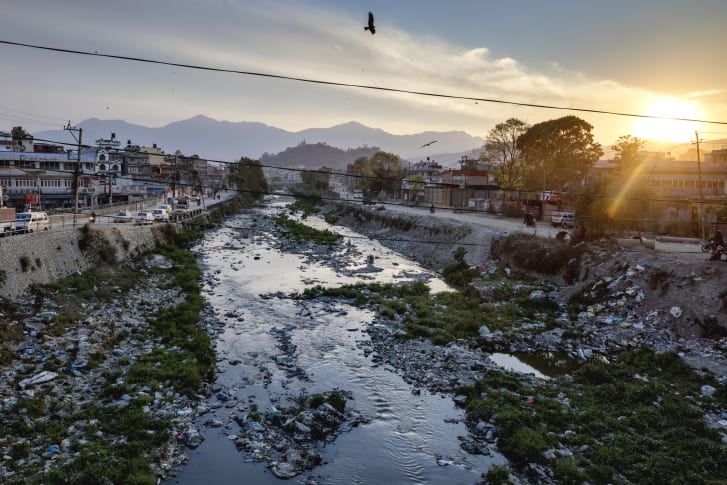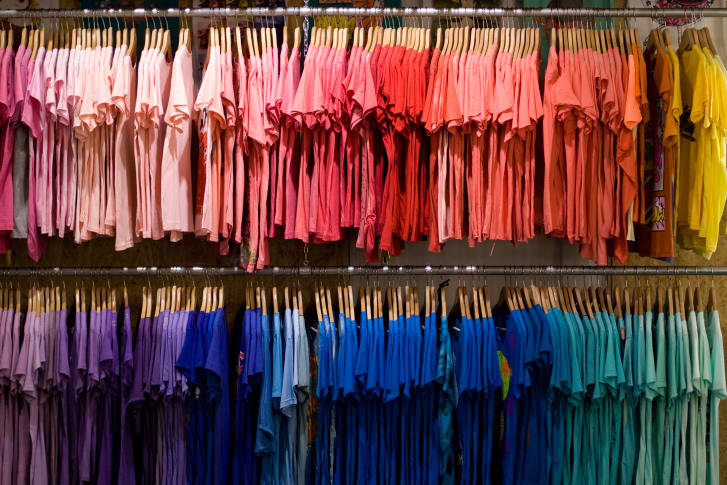Bacteria can help fix fashion's water pollution problem
Published on by Water Network Research, Official research team of The Water Network in Case Studies
In 2013, a team of Cambridge University scientists were in Nepal's Kathmandu Valley, developing a device to measure pollution in the region's waters.
The scientists spoke to local people, who relied on the filthy streams and rivers for their water supply, and learned that waste from textile factories was contaminating the waterways.
"We were shocked," says Orr Yarkoni, one of the researchers on the expedition.
The scientists analyzed the water and their findings aligned with what the locals said -- most of the hazardous chemicals came from the textile industry.
Nepal is one of the most water-abundant countries in the world, but water pollution is a major problem. More than 85% of the population doesn't have access to safe drinking water.

Garbage floats on the Bisnumati River in Kathmandu, Nepal, alongside a flood of less visible pollutants, many from the valley's textile factories. Credit: Jonas Gratzer/LightRocket/Getty Images
"That feeling of 'I have no safe water to drink' is something that no human should have to feel in this day and age," says Yarkoni.
"When we realized that so much of the pollution comes from something as simple as putting color into our clothes, we thought 'there has to be a better way,'" he says.
Three years later, that thinking spurred Yarkoni and two Cambridge University colleagues, Jim Ajioka and David Nugent, to co-found Colorifix and develop a new way to dye clothes that won't harm the planet. Yarkoni claims the technology they have developed eliminates the need for toxic chemicals. It also uses up to 90% less water and up to 40% less energy than the conventional dyeing process, he says.

Our taste for colorful clothes comes at a cost to the environment. Textile production pollutes water and generates more emissions than all international flights and maritime shipping combined, according to a 2017 report by the Ellen MacArthur Foundation. Credit: janzgrossetkino/Moment RF/Getty Images
The color purple
For millennia, people used natural dyes to color fabrics.
Then in 1856, chemist William Henry Perkin had a serendipitous accident.
Perkin was trying to produce quinine, a substance used to treat malaria, when he inadvertently created the first synthetic dye -- a vivid purple substance which easily transferred onto cloth.
The purple dye opened a floodgate of synthetic color possibilities that revolutionized the world of fashion. But with it came a torrent of environmental problems.
Today, the dyeing industry uses more than 8,000 chemicals. Many, including sulfur, arsenic and formaldehyde, are harmful to wildlife and human health.

Perkin called his invention mauveine. It heralded a new era for the fashion industry. Credit: Science & Society Picture Librar/SSPL/SSPL via Getty Images
In less developed Asian countries, which produce a large share of the world's clothes, weak regulation enforcement means that many textile manufacturers dump toxic substances directly into local waterways. And it's happening on a massive scale -- the dyeing process uses enough water to fill 2 million Olympic-sized swimming pools each year. This makes the dyeing industry one of the most environmentally harmful in the world, responsible for up to one fifth of industrial water pollution.
Finding microscopic solutions
The device Orr and his team developed to test water pollution in Nepal used genetically modified bacteria that changed color when exposed to hazardous chemicals.
He and his business partners decided to harness the bacteria's color-changing ability to develop their dyeing innovation.
Colorifix -- based in Norwich, in the east of England -- produces dyes that are inspired by "nature's blueprints." But the technology doesn't derive pigments straight from plants or animals, like traditional natural dyeing methods. Instead, it copies nature's processes in a lab setting, by replicating the "DNA message" that codes for color in an organism.
Yarkoni says Colorifix has made pigments using genetic code taken from plants, dragonflies and gorillas, among others, using DNA information sourced from scientific studies. "We don't like bothering animals," he adds.
Colorifix inserts the genetic information that directs the color-making process into a bacterial cell, which copies itself every 25 minutes. The bacteria are fed with sugar molasses and nitrogen -- by-products of the agricultural industry -- in a fermenting machine, where the cells multiply in number, each making more pigment.
Yarkoni likens the fermentation process to making beer, "but instead of making alcohol, we're making the pigments."
Taxonomy
- Textile
- Bacteria
- Empowerment & Right To Water
- Water Pollution Control
- Fibers & Textiles
- Textile
- waste water bacteria
1 Comment
-
Colorifix has made fantastic name world over, proud of its Achievement